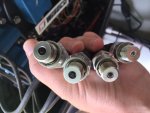kcantlon
Cadet
- Joined
- Sep 23, 2014
- Messages
- 15
Hello all!
I have a 1989 Force 125hp Outboard and I need some help.
Recently had it on the water and was experiencing hard starting, rough idle, low power, and high rpm surging (+/- 500rpm)
I had just replaced the spark plugs prior to this lake trip, so I started by pulling the plugs to check their condition (~3hrs old).
1. Plugs 1 & 2 look normal, plug 3 looks almost new, plug 4 looks brand new. (See pic, plugs 1-4, left to right)
2. Cranked the motor to check for spark. All plugs were sparking well IMO. More blue on 1 & 2.
3. Checked compression. ~120psi on all 4 cylinders.
4. Checked, cleaned, and sanded ALL electrical connections.
5. Re-checked spark. Same as before.
6. Put motor on muffs, fired it up, and let it idle. Rough idle... and heavy smell of raw fuel from exhaust.
7. Pulled the plug wire off of cylinder #4 while running with no change in performance.
8. Removed plug #4 to see if it was "wet" with fuel. It was soaked with fuel.
I am convinced that the CD Box that feeds coils 3 & 4 is probably bad, but I am surprised I am still seeing a fairly strong spark? I understand plugs will not arc under compression if getting supplied with low voltage.
Are there any other checks I should do before investing in a new CD Box? Could this be a trigger issue?

Thanks,
Kyle
I have a 1989 Force 125hp Outboard and I need some help.
Recently had it on the water and was experiencing hard starting, rough idle, low power, and high rpm surging (+/- 500rpm)
I had just replaced the spark plugs prior to this lake trip, so I started by pulling the plugs to check their condition (~3hrs old).
1. Plugs 1 & 2 look normal, plug 3 looks almost new, plug 4 looks brand new. (See pic, plugs 1-4, left to right)
2. Cranked the motor to check for spark. All plugs were sparking well IMO. More blue on 1 & 2.
3. Checked compression. ~120psi on all 4 cylinders.
4. Checked, cleaned, and sanded ALL electrical connections.
5. Re-checked spark. Same as before.
6. Put motor on muffs, fired it up, and let it idle. Rough idle... and heavy smell of raw fuel from exhaust.
7. Pulled the plug wire off of cylinder #4 while running with no change in performance.
8. Removed plug #4 to see if it was "wet" with fuel. It was soaked with fuel.
I am convinced that the CD Box that feeds coils 3 & 4 is probably bad, but I am surprised I am still seeing a fairly strong spark? I understand plugs will not arc under compression if getting supplied with low voltage.
Are there any other checks I should do before investing in a new CD Box? Could this be a trigger issue?

Thanks,
Kyle






















